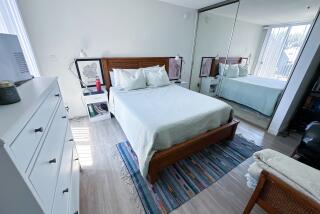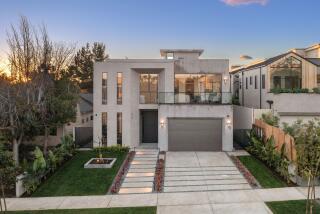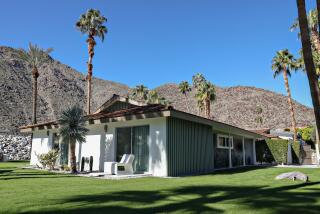The kitchen, revisited
- Share via
HIDDEN behind a downturn in the stock market, pain at the gas pump and historic home foreclosures, the high-end designer kitchen gleams on. The remodeling business may be off in parts of Southern California, and some consumers may be rethinking the need for $8,000 professional ranges, granite-topped islands and extra dishwashers, but in the words of Los Angeles interior designer Karen Haas: Clients still want “the best, the brightest, the latest.”
“They’re wanting these gadgety things,” says Cynthia Bennett of Cynthia Bennett & Associates in South Pasadena. “Wine refrigerators have become a staple, plus built-in coffee makers and speed ovens.”
Whether people are actually cooking more remains unclear, but the primacy of the kitchen as a public shrine seems, for the moment, secure. “I call them Lean Cuisine kitchens,” Haas says, referring to her suspicion that warming a frozen dinner might be the height of culinary expertise expended by some owners of $5,000 ranges -- not counting occasions when the equipment is turned over to caterers.
“No one’s going toward Kitchen-Aid and the regular GE,” says Susan Serra, a prominent New York designer whose clients spend on average between $150,000 and $200,000 on new kitchens that sport professional-grade equipment by the likes of SubZero and Fisher & Paykel. “I’ve been against these big appliances from Day One. . . . What people forget is what they really need.”
Mid-market manufacturers such as Kenmore and Frigidaire have introduced versions of the high-end ranges for a fraction of the cost. And in the opinion of Los Angeles kitchen remodeling contractor David Ceballos, they’re often just as good.
“You’re paying for the brand name,” he says of the others. But even people on a budget, Ceballos says, “still want that professional look.”
Overall appliance sales have flattened, according to the National Kitchen and Bath Assn. But Elaine Chaney, senior vice president for marketing and sales for Dacor, the pricey appliance manufacturer based in Diamond Bar, says its customers still want high style -- as long as it comes with intuitive technology that doesn’t require a degree from Caltech to operate.
“Lots of families depend on the high school senior to put a roast chicken in the oven for dinner because both parents are working,” Chaney says.
--
Many OF the new computerized, dual-fuel, multiple-keypad ovens require much more than turning a knob. These hefty, restaurant-worthy stainless steel icons from Viking, Wolf and others make a statement and deliver charring power, but the question is: To what extent are they necessary for the average family’s menu -- even a gourmet menu?
“What’s really impressive is being able to sear a steak,” says Matthew Lee, a James Beard Award-winning cookbook author, describing what a 15,000-BTU gas burner can accomplish that most home stoves with 1,800 to 3,000 BTUs cannot. Yet Lee and his brother Ted, co-author of “The Lee Bros. Southern Cookbook,” deliberately make do with “a crappy four-burner Modern Chef” stove in a Manhattan apartment so as to better develop recipes for the average cook.
“If you poke your nose into the world of the been-there-done-that chef like Bobby Flay,” Matthew Lee says, “it’s not the size of the kitchen you’ll notice but its efficiency.”
As revealed in the how-to videos on www.danielnyc.com, the home kitchen of Daniel Boulud, the chef-owner of the top-rated restaurant Daniel in New York City, is relatively small, even cramped.
“Space is so dramatically wasted in many of these mansions on steroids,” says Katherine Austin, a member of the American Institute of Architects’ Housing and Custom Residential advisory group. “You can have high-end appliances in a small space.”
The endurance of the showroom-quality kitchen indicates that homeowners still regard this once-utilitarian part of the house to be an emblem of status, as significant to their self-image as the car they drive. Plus, real estate agents and (surprise) kitchen designers will tell you that a camera-ready kitchen is key to a home’s resale value.
Research data on consumer preferences released by the American Institute of Architects in February indicated “kitchens continue to be the dominant design area within the home, with dedicated computer work areas and cellphone and personal digital assistant recharging stations becoming an emerging trend.”
For those waiting for the kitchen to come back down to Earth, there was a glimmer of hope: The study noted a slight retreat from top-of-the-line appliances.
One factor that may speed the change in mind-set: the growing interest in green building and renovation, with an emphasis on energy efficiency, using renewable resources and generally eschewing the kind of excess that has been a hallmark of many recent remodels.
The AIA survey found that 49% of the respondents wanted renewable countertop materials like ceramic tile and IceStone (made from recycled glass), as opposed to quarried, irreplaceable stone like granite.
--
EVEN IF environmental concerns don’t sway them, some homeowners are dialing back their kitchen plans because of budget.
Bennett says she’s been getting more calls for “face-lifts” rather than complete overhauls. Given the uncertain economy, she says, “I think a lot of people are waiting to see what’s going to happen.”
Denys Barbas, a designer with California Kitchens in Burbank, expects changes to be minor, at least at first. “If anything, they’ll pull back on some of the niche items, like the $2,000 built-in coffee maker,” she says.
David Glasband, a longtime kitchen contractor based in the San Fernando Valley, is less sanguine, noting that his business is off 70% to 80% over the last six to nine months. “The ultra wealthy people are still buying their Vikings, but aside from them, the Valley has been impacted. Everybody’s scared and sitting on their money.”
Textile designer Martine Bednarski of Eagle Rock bought her otherwise elegant 1928 Spanish Colonial revival home near Occidental College a few years ago and was faced with “a dark and ugly” kitchen that she knew she had to renovate -- but on a budget. The space was limited and so was her wish list, but she had difficulty finding a contractor willing to entertain any job less than $50,000.
“I finally found someone in San Dimas who would do it,” Bednarski says.
Instead of moving the washer and dryer to the basement (which would mean more steps), she decided to mask them with waist-level curtains, and got a hardwood floor that matched the rest of the house, a marble countertop, new light-colored cabinets, a free-standing pantry and open shelving.
She settled for a standard Tappan range and bought one expensive appliance: a compact Miele refrigerator that she wanted to look good because of its stand-alone placement next to an entry.
Her final bill: $40,700.
“I didn’t compromise much at all,” Bednarski says, giving up only a custom cabinet she originally wanted for the dishwasher.
The result is a handsome and practical kitchen that might not be large enough to make a caterer happy but that suits her needs as a single mom who, in fact, does a lot of cooking. “I don’t think I would do it now,” she says, “because I probably wouldn’t be able to afford it.”
--


